Using Modified Remote Sensing Imagery to Interpret Changes in Cultivated Land under Saline-Alkali Conditions
Abstract
:1. Introduction
2. Materials and Methods
2.1. Study Site
2.2. Data Source
2.3. Methods
3. Modified Remote Sensing Imagery
3.1. Saline-Alkali Land Classification
3.2. New Interpretation Symbol System
3.3. Classification Templates
3.4. Saline-Alkali Land Information Extraction
3.5. Validation of Remote Sensing Interpretation
4. Results
4.1. Temporal Changes in Arable Saline-Alkali Land
4.2. Spatial Changes in Saline-Alkali Arable
5. Discussions
5.1. Method Feasibility
5.2. Changes in Cultivated Lands
6. Conclusions
Acknowledgments
Author Contributions
Conflicts of Interest
References
- Martinez-Beltran, J.; Manzur, C.L. Overview of salinity problems in the world and FAO strategies to address the problem. In Proceedings of the International Salinity Forum, Riverside, CA, USA, 25–27 April 2005; pp. 311–313.
- Rengasamy, P. World salinization with emphasis on Australia. J. Exp. Bot. 2006, 57, 1017–1023. [Google Scholar] [CrossRef] [PubMed]
- Abbas, A.; Khan, S.; Hussain, N.; Hanjra, M.A.; Akbar, S. Characterizing soil salinity in irrigated agriculture using a remote sensing approach. Phys. Chem. Earth 2013, 55–57, 43–52. [Google Scholar] [CrossRef]
- Metternicht, G.I. Catwgeorical fuzziness: A comparison between crisp and fuzzy class boundary modeling for mapping salt-affected soils using Landsat TM data and a classification based on anion ratios. Ecol. Model. 2003, 168, 371–389. [Google Scholar] [CrossRef]
- Farifteh, J.; Farshad, A.; George, R.J. Assessing salt-affected soil using remote sensing solute modeling, and geophysics. Geoderma 2006, 130, 191–206. [Google Scholar] [CrossRef]
- Masoud, A.A.; Koike, K. Arid land salinization detected by remotely-sensed landcover changes: A case study in the Siwa region, NW Egypt. J. Arid. Environ. 2006, 66, 151–167. [Google Scholar] [CrossRef]
- Dwivedi, R.S.; Rao, B.R.M. The selection of the best possible Landsat TM band combination for delineating salt-affected soils. Int. J. Remote Sens. 1992, 13, 2051–2058. [Google Scholar] [CrossRef]
- Dwivedi, R.S.; Sreenivas, K. Delineation of salt-affected soils and waterlogged areas in the Indo-Gangetic plains using IRS-1C LISS-III data. Int. J. Remote Sens. 1998, 19, 2739–2751. [Google Scholar] [CrossRef]
- Metternichet, G.I.; Zinck, J.A. Spatial discrimination of salt- and sodium-affected soils surfaces. Int. J. Remote Sens. 1997, 18, 2571–2586. [Google Scholar] [CrossRef]
- Yu, R.; Liu, T.; Xu, Y.; Zhu, C.; Zhang, Q.; Qu, Z.; Liu, X.; Li, C. Analysis of salinization dynamics by remote sensing in Hetao Irrigation District of North China. Agric. Water Manag. 2010, 97, 1952–1960. [Google Scholar] [CrossRef]
- Wang, H.; Fan, Y.; Tashpolat, T. The research of soil salinization human impact based on remote sensing classification in oasis irrigation area. Procedia Environ. Sci. 2011, 10, 2399–2405. [Google Scholar]
- Yuan, Y. A study on ecosystem services value for 38° N ecological transect of Hebei Province. Ph.D. Thesis, University of Chinese Academy of Sciences, China, June 2012. [Google Scholar]
- Geospatial Date Cloud. Available online: http://www.gscloud.cn/sources/?cdataid=263&pdataid=10 (accessed on 10 December 2013).
- Sun, J.; Yang, J.; Zhang, C.; Yun, W.; Qu, J. Automatic remotely sensed image classification in a grid environment based on the maximum likelihood method. Math. Comp. Model. 2013, 58, 573–581. [Google Scholar] [CrossRef]
- Hagner, O.; Reese, H. A method for calibrated maximum likelihood classification of forest types. Remote Sens. Environ. 2007, 110, 438–444. [Google Scholar] [CrossRef]
- Bao, Y.; Wulantuya, H.; Xiang, B.; Zhao, X.L. Studies on the movement of farmland gravity and analyses of its driving factors in Inner Mongolia. China Prog. Geogr. 1998, 17, 47–54. [Google Scholar]
- Duan, H.; Tao, W.; Xue, X.; Liu, S.; Guo, J. Dynamics of aeolian desertification and its driving forces in the Horqin Sandy Land, Northern China. Environ. Monit. Assess. 2014, 186, 6083–6096. [Google Scholar] [CrossRef] [PubMed]
- Liu, X.; Dong, G.; Xigang, W.; Xue, Z.; Jiang, M.; Lu, X.; Zhang, Y. Characterizing the spatial pattern of marshlands in the Sanjiang Plain, Northeast China. Ecol. Eng. 2013, 53, 335–342. [Google Scholar] [CrossRef]
- GB/T 21010-2007. Available online: http://www.biaozhun8.cn/so.asp?k=GT%2FB21010-2007 (accessed on 29 June 2016). (In Chinese)
- Zhang, S.-W.; Yang, J.-C.; Li, Y.; Zhang, Y.-Z.; Chang, L.-P. Change of saline-alkali land in northeast China and its causes since the mid-1950s. J. Nat. Res. 2010, 25, 435–442. (In Chinese) [Google Scholar]
- Dwivedi, R.S.; Sreeniv, K.; Ramana, K.V. Inventory of salt-affected soils and water logged areas: A remote sensing approach. Int. J. Remote Sens. 1999, 20, 1589–1599. [Google Scholar] [CrossRef]
- Yue, Y.-J.; Zhang, F.; Zhang, G.-M.; Zhang, H.; Xu, P.-H.; Wang, J.-A. Coastal saline-alkali land use change and its optimization. Res. Sci. 2010, 32, 423–430. (In Chinese) [Google Scholar]
- Guan, Y.X.; Liu, G.H. Remote sensing detection of dynamic variation of the saline land in the yellow river delta. Remote Sens. Land Resour. 2003, 2, 19–22. (In Chinese) [Google Scholar]
- Ma, T.J.; Zhao, M.R.; Matsumoto, S.; Yamazaki, J. Evolution of saline-alkali soils in Heilong-gang region. Acta Pedologica Sinica 1995, 32, 228–234. (In Chinese) [Google Scholar]
- Ibrahimi, M.K.; Miyazaki, T.; Nishimura, T.; Imoto, H. Contribution of shallow groundwater rapid fluctuation to soil salinization under arid and semiarid climate. Arab. J. Geosci. 2014, 7, 3901–3911. [Google Scholar] [CrossRef]
- Jin, X.M.; Vekerdy, Z.; Zhang, Y.-K.; Liu, J.T. Soil Salt content and its relationship with crops and groundwater depth in the Yinchuan Plain (China) using remote sensing. Arid. Land Res. Manag. 2010, 26, 227–235. [Google Scholar] [CrossRef]
- Kairis, C.; Kosmas, C.; Karavitis, C.; Ritsema, L.; Salvati, S.; Acikalin, M.; Alcala, P.; Atlhopheng, J.; Barrera, J.; Belgacem, A.; et al. Evaluation and selection of indicators for land degradation and desertification monitoring: Types of degradation, causes, and implications for management. Environ. Manag. 2014, 54, 971–982. [Google Scholar] [CrossRef] [PubMed]
- Konukcu, F.; Gowing, J.W.; Rose, D.A. Dry drainage: A sustainable solution to waterlogging and salinity problems in irrigation areas? Agric. Water Manag. 2006, 83, 1–12. [Google Scholar] [CrossRef]
- Zhang, Z.; Abuduwaili, J.; Yimit, H. The occurrence, sources and spatial characteristics of soil salt and assessment of soil salinization risk in Yanqi Basin, Northwest China. PLoS ONE 2014, 9, 1–12. [Google Scholar] [CrossRef] [PubMed]
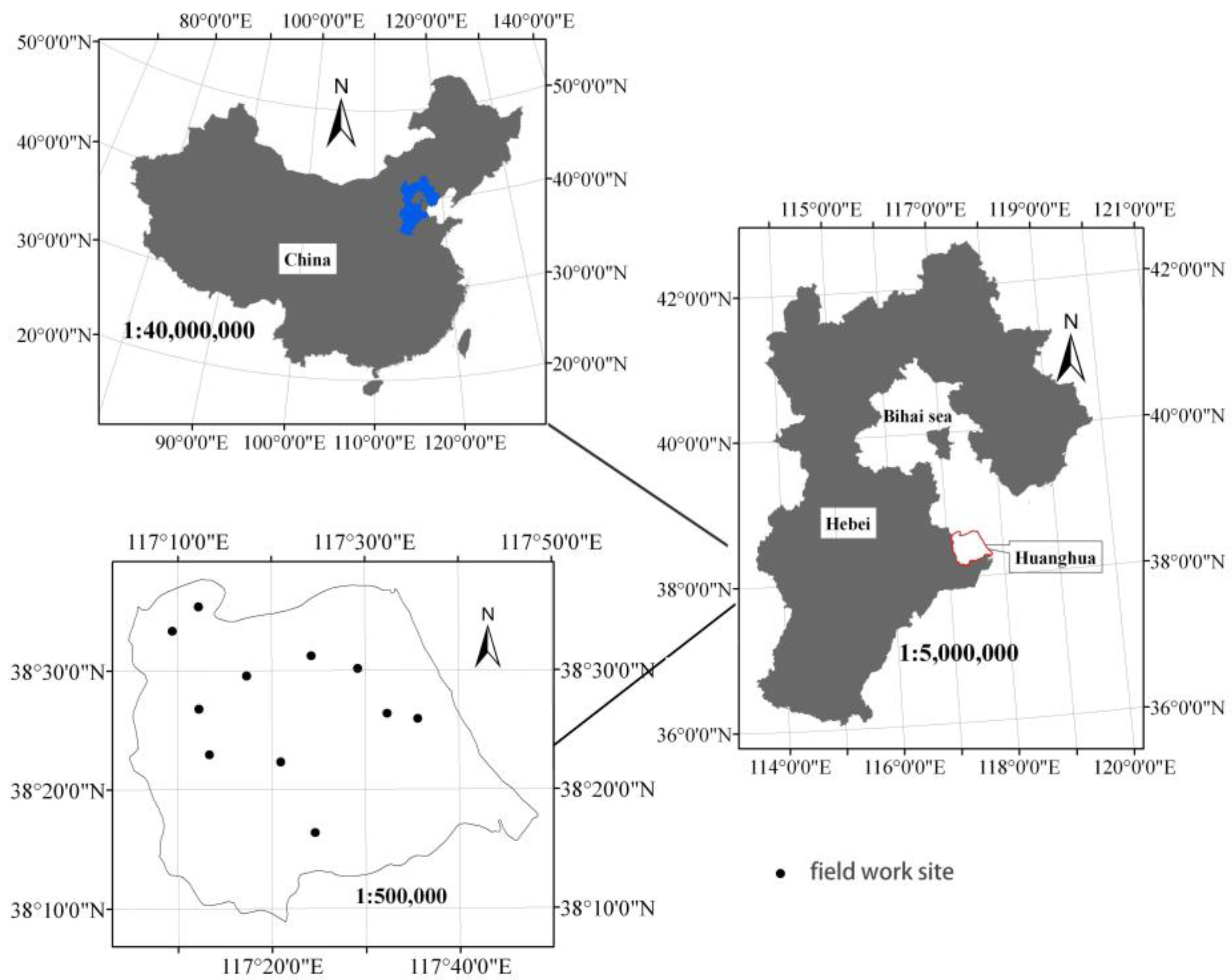

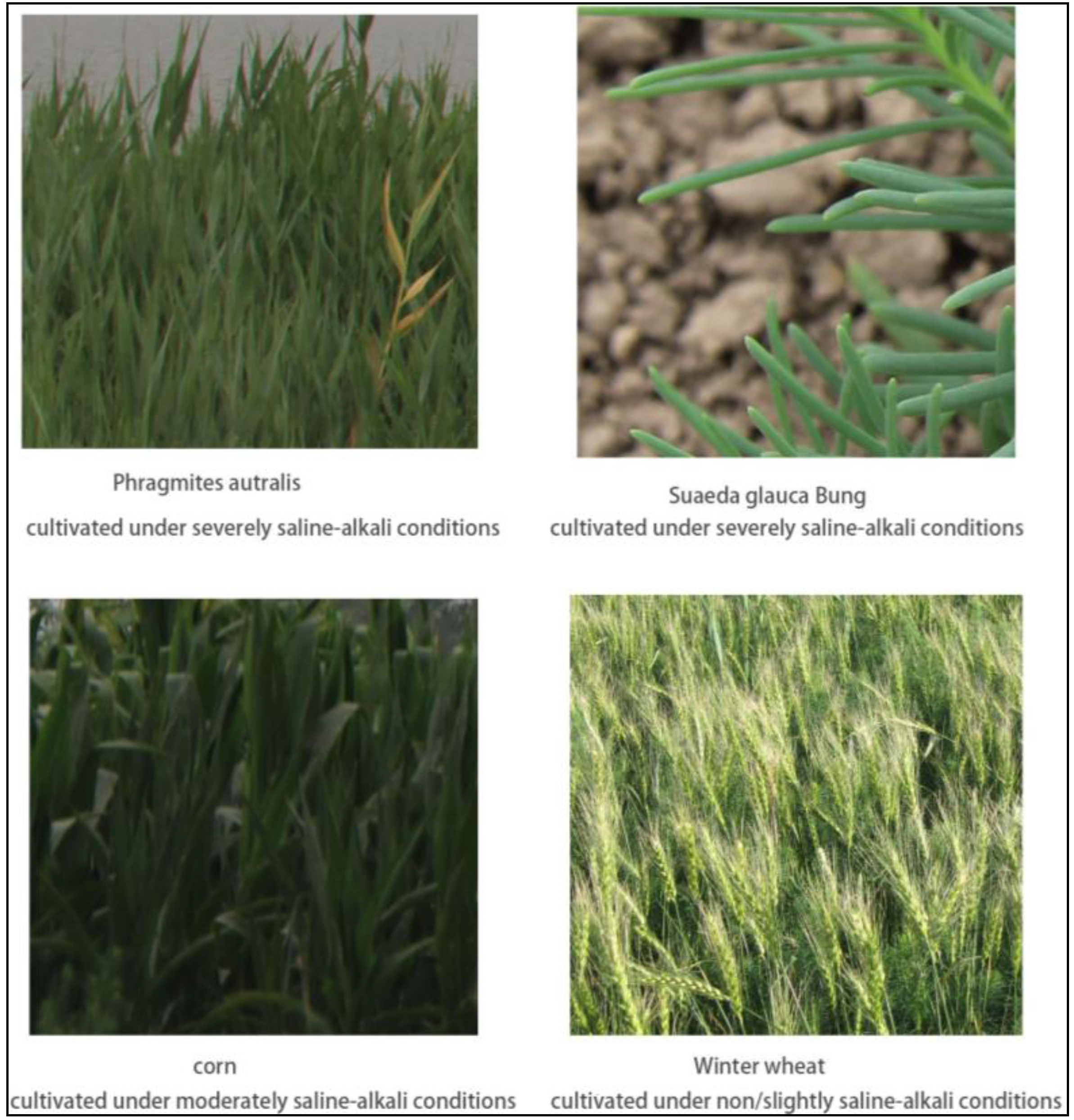

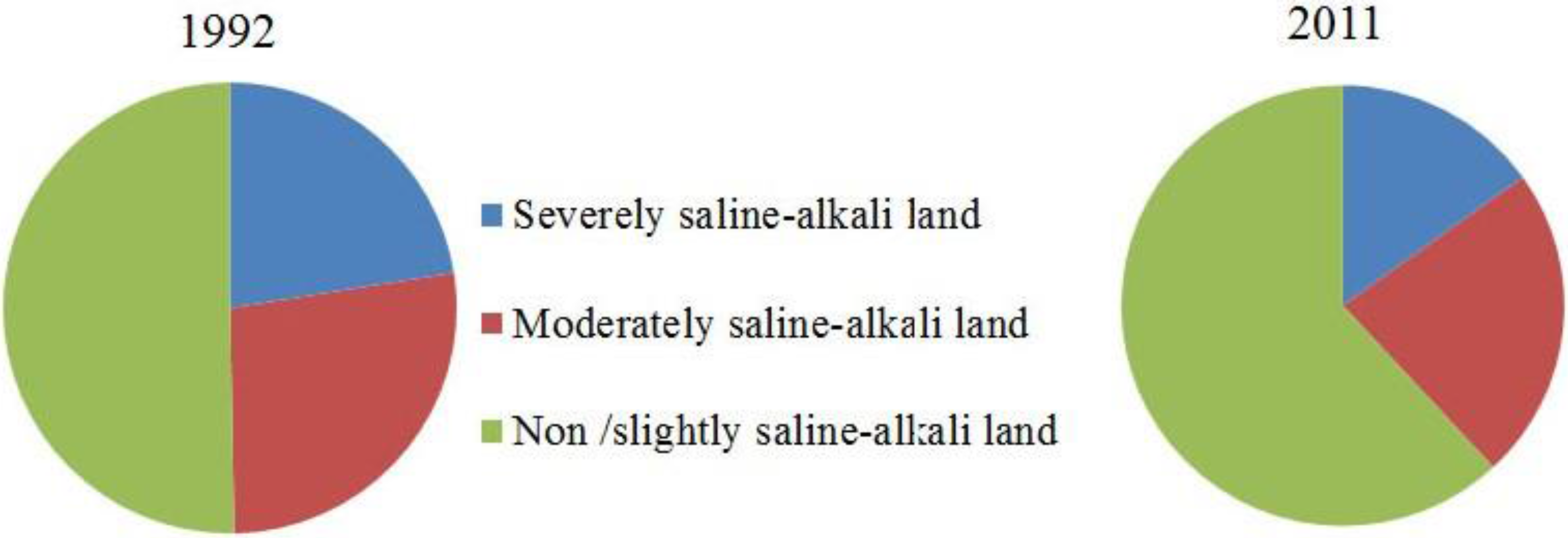
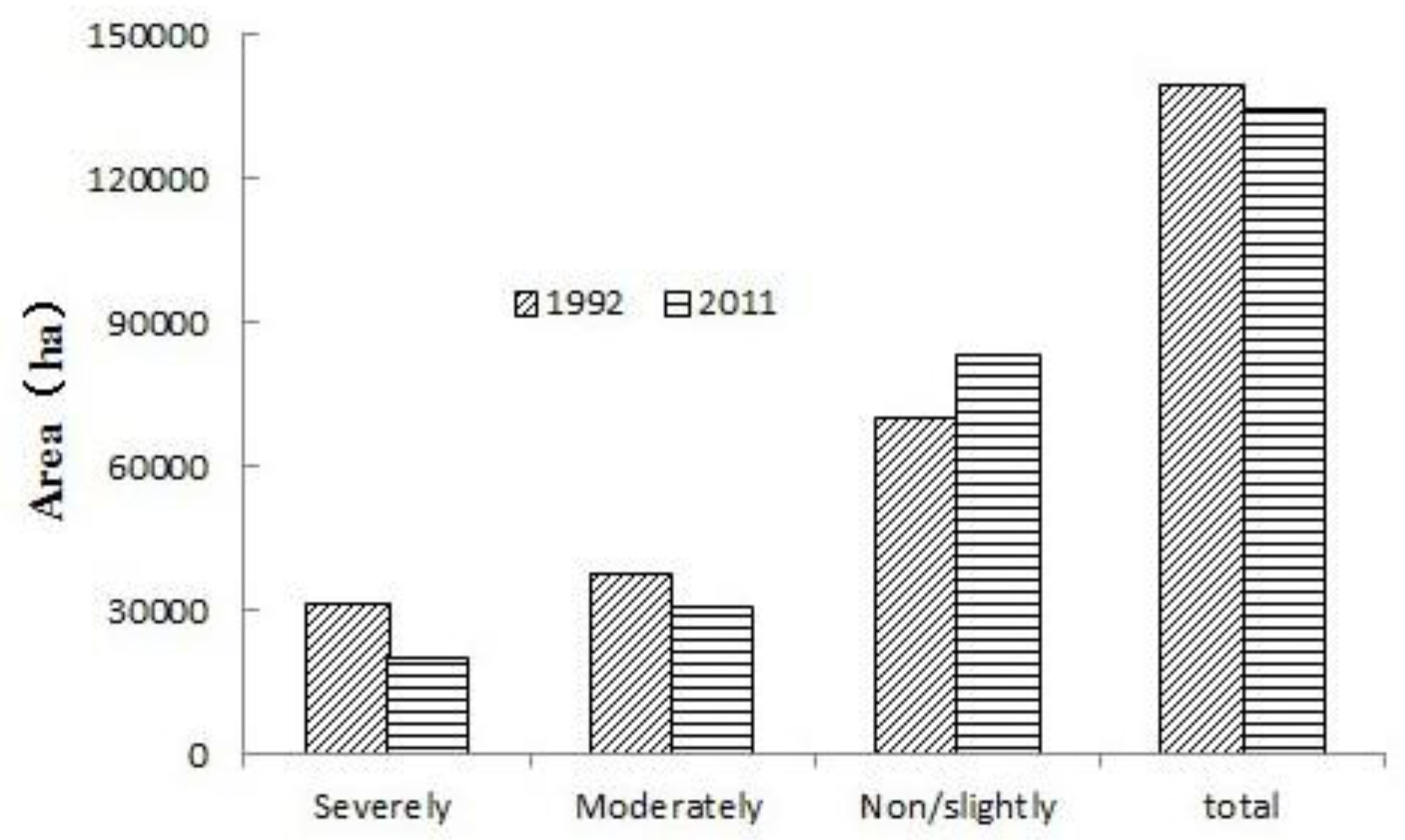
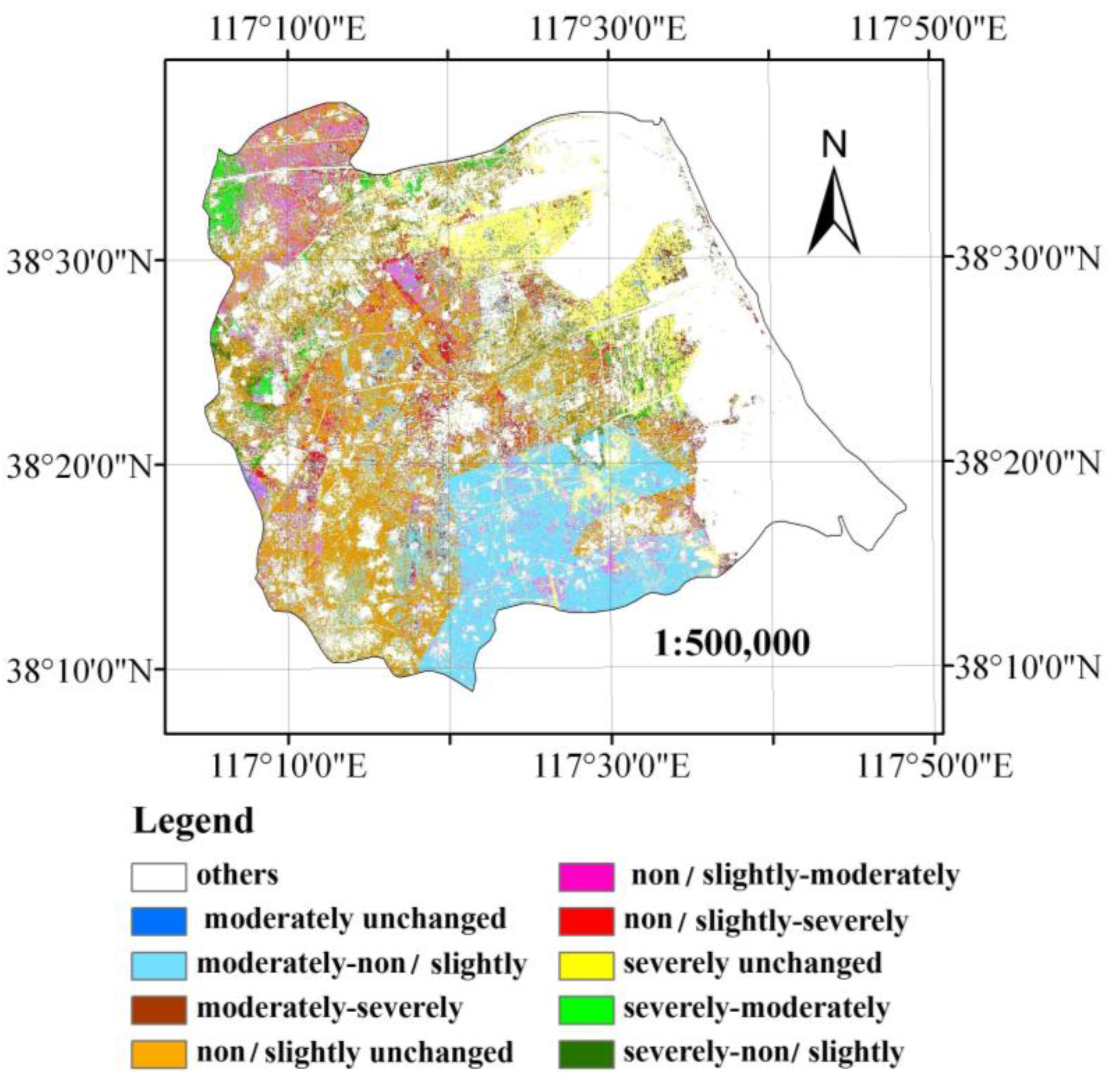
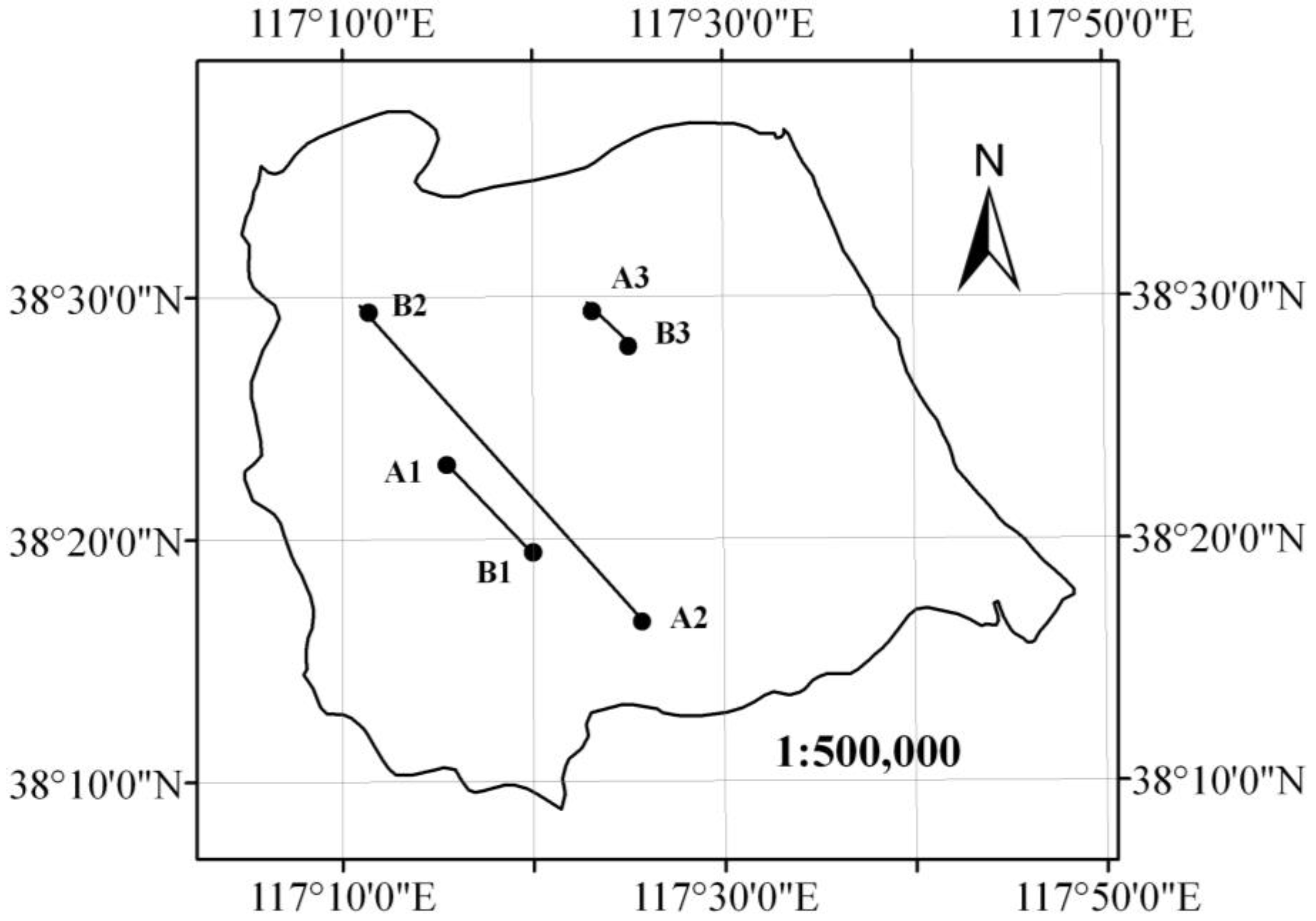
| Classes of Saline-Alkali Land | Vegetation Feature | Image Feature |
|---|---|---|
| Severely saline-alkali land | Salt-resistant vegetation |  |
| Moderately saline-alkali land | Spring corn, cotton |  |
| Non/slightly saline-alkali land | Winter wheat |  |
| Classification | Severely | Moderately | Non/Slightly | Residential Land | Marsh Land | Aquaculture | Salt Pot | Water |
|---|---|---|---|---|---|---|---|---|
| Severely | 1509 | 0 | 19 | 26 | 28 | 1 | 0 | 0 |
| Moderately | 8 | 1562 | 67 | 70 | 6 | 0 | 0 | 0 |
| Non/slightly | 25 | 0 | 1126 | 4 | 94 | 0 | 0 | 0 |
| Residential land | 3 | 15 | 6 | 1141 | 24 | 1 | 3 | 0 |
| Marsh land | 3 | 0 | 2 | 0 | 1091 | 0 | 0 | 0 |
| Aquaculture | 0 | 0 | 0 | 0 | 0 | 657 | 3 | 38 |
| Salt pot | 0 | 0 | 0 | 0 | 1 | 3 | 370 | 1 |
| Water | 0 | 0 | 0 | 0 | 0 | 14 | 38 | 552 |
| Total | 1548 | 1577 | 1220 | 1241 | 1244 | 676 | 414 | 591 |
| Classifications accuracy | 97.48 | 99.05 | 92.30 | 91.94 | 87.70 | 97.19 | 89.37 | 93.40 |
| Classification | Severely | Moderately | Non/Lightly | Residential Land | Marsh Land | Aquaculture | Salt Pot | Water |
|---|---|---|---|---|---|---|---|---|
| Severely | 355 | 49 | 37 | 23 | 9 | 0 | 2 | 0 |
| Moderately | 7 | 1362 | 81 | 89 | 6 | 0 | 0 | 0 |
| Non/slightly | 1 | 25 | 1500 | 22 | 51 | 0 | 0 | 0 |
| Residential land | 6 | 53 | 21 | 1691 | 99 | 1 | 3 | 0 |
| Marsh land | 1 | 0 | 7 | 4 | 1300 | 0 | 0 | 0 |
| Aquaculture | 0 | 0 | 0 | 4 | 3 | 1808 | 0 | 0 |
| Salt pot | 0 | 0 | 0 | 0 | 0 | 3 | 449 | 39 |
| Water | 0 | 0 | 0 | 10 | 0 | 71 | 16 | 605 |
| Total | 370 | 1489 | 1646 | 1843 | 1468 | 1883 | 470 | 644 |
| Classifications accuracy | 95.95 | 91.47 | 91.13 | 91.75 | 88.56 | 96.02 | 95.53 | 93.94 |
| Classes | Non/Lightly | Moderately | Severely | Residential Land | Marsh Land | Salt Pot | Water Body | Aquaculture |
|---|---|---|---|---|---|---|---|---|
| Non/lightly | 38746.9 | 12125.1 | 6540.3 | 10139.2 | 1756.26 | 253.53 | 486.9 | 129.96 |
| Moderately | 24770.6 | 1187.55 | 2243.88 | 2408.4 | 135.45 | 236.16 | 316.62 | 127.08 |
| Severely | 7470.18 | 3575.16 | 14930.5 | 6701.85 | 874.61 | 746.01 | 362.24 | 1324.17 |
| Residential land | 8204.76 | 2805.03 | 2838.78 | 10419.7 | 227.88 | 436.59 | 425.07 | 163.8 |
| Marsh land | 3704.22 | 561.87 | 3645.99 | 1669.77 | 8685.63 | 61.29 | 268.65 | 400.77 |
| Salt pot | 291.78 | 68.76 | 255.24 | 573.84 | 12.42 | 2280.06 | 2558.25 | 472.41 |
| Water body | 18.99 | 21.24 | 272.88 | 346.32 | 20.52 | 2538.27 | 9342.63 | 10504.6 |
| Aquaculture | 8.64 | 28.53 | 160.56 | 372.6 | 3.78 | 1132.47 | 2310.48 | 345.69 |
© 2016 by the authors; licensee MDPI, Basel, Switzerland. This article is an open access article distributed under the terms and conditions of the Creative Commons Attribution (CC-BY) license (http://creativecommons.org/licenses/by/4.0/).
Share and Cite
Gao, H.; Liu, J.; Eneji, A.E.; Han, L.; Tan, L. Using Modified Remote Sensing Imagery to Interpret Changes in Cultivated Land under Saline-Alkali Conditions. Sustainability 2016, 8, 619. https://doi.org/10.3390/su8070619
Gao H, Liu J, Eneji AE, Han L, Tan L. Using Modified Remote Sensing Imagery to Interpret Changes in Cultivated Land under Saline-Alkali Conditions. Sustainability. 2016; 8(7):619. https://doi.org/10.3390/su8070619
Chicago/Turabian StyleGao, Hui, Jintong Liu, A. Egrinya Eneji, Lipu Han, and Limei Tan. 2016. "Using Modified Remote Sensing Imagery to Interpret Changes in Cultivated Land under Saline-Alkali Conditions" Sustainability 8, no. 7: 619. https://doi.org/10.3390/su8070619
APA StyleGao, H., Liu, J., Eneji, A. E., Han, L., & Tan, L. (2016). Using Modified Remote Sensing Imagery to Interpret Changes in Cultivated Land under Saline-Alkali Conditions. Sustainability, 8(7), 619. https://doi.org/10.3390/su8070619





